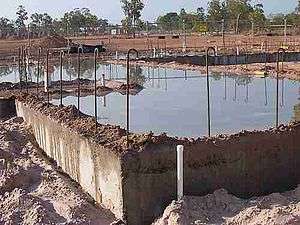Curing (chemistry)

Curing is a term in polymer chemistry and process engineering that refers to the toughening or hardening of a polymer material by cross-linking of polymer chains, brought about by electron beams, heat or chemical additives. When the additives are activated by ultraviolet radiation, the process is called UV Cure.[1] In rubber, the curing process is also called vulcanization.
Resin curing
Despite the wide variety of thermoset resin formulations (epoxy, vinylester, polyester, etc.), their cure behavior is qualitatively identical. The resin viscosity drops initially upon the application of heat, passes through a region of maximum flow and begins to increase as the chemical reactions increase the average length and the degree of cross-linking between the constituent oligomers. This process continues until a continuous 3-dimensional network of oligomer chains is created – this stage is termed gelation. In terms of processability of the resin this marks an important watershed: before gelation the system is relatively mobile, after it the mobility is very limited, the micro-structure of the resin and the composite material is fixed and severe diffusion limitations to further cure are created. Thus in order to achieve vitrification in the resin, it is usually necessary to increase the process temperature after gelation. Cure monitoring methods give a significant insight to the chemical process and define process actions towards achieving specific quality indices of the cured resin systems.
Types of curing
See also
- Vulcanization
- Tablet curing[2]
References
- ↑ Gregory T. Carroll, Nicholas J. Turro and Jeffrey T. Koberstein (2010) Patterning Dewetting in Thin Polymer Films by Spatially Directed Photocrosslinking Journal of Colloid and Interface Science, Vol. 351, pp 556-560 doi:10.1016/j.jcis.2010.07.070
- ↑ Gendre C., Genty M., César da Silva J., Tfayli A., Boiret M., Lecoq O., Baron M., Chaminade P., Péan J-M., Comprehensive study of dynamic curing effect on tablet coating structure, Eur. J. Pharm. Biopharm., 81 (2012), 657-665
- Osswald, Tim A.; Menges, Georg (2003). Materials science of polymers for engineers. Hanser Verlag. pp. 334–335. ISBN 978-1-56990-348-3.
- Glöckner, Patrick (2009). Radiation Curing. Vincentz Network. pp. 11–16. ISBN 978-3-86630-907-4.